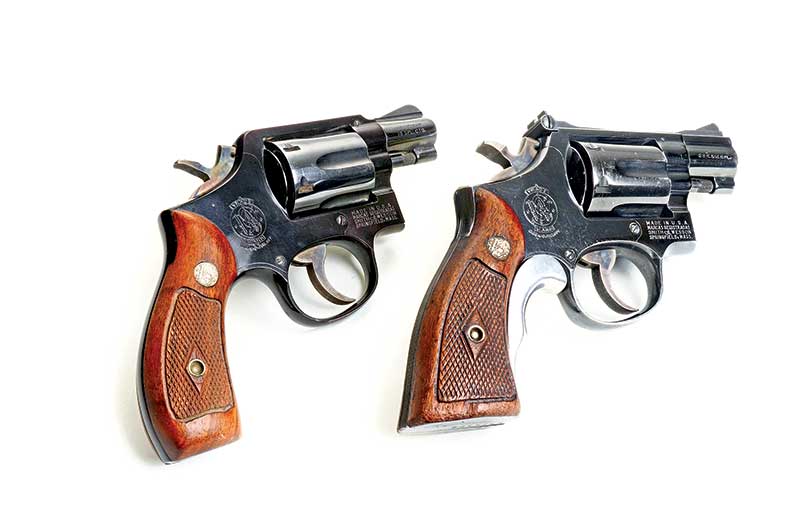Snub-Nosed S&W's
Before J-Frames
When someone says snub-nosed Smith & Wessons to us ancient sorts, my mental image is of a 5-shot, .38 Special J-Frame with a 2″ barrel. Prime examples are the Model 36 Chief’s Special, Model 38 Bodyguard, Model 43 Centennial Airweight or even the Model 60 Chief’s Special Stainless.
For nearly 45 years before the J-Frames’ debut, Smith & Wesson had other revolvers with 2″ barrels. They were 6-shooters, built on the K-Frame; again mostly .38 Specials but some .32’s and also some chambered for the ancient .38 S&W. These were the famed Military & Police, a moniker which stuck even after Model 10 was applied to them in 1957.
The K-Frame appeared in 1899 as an introductory vehicle for the new .38 S&W Special but was also chambered as .32-20. It was not until 1905 a 2″ barrel was offered. Butt shape could be round or square and finish could be blue or nickel-plated. Both versions had color case hardened triggers and hammers. Perhaps the visual dead giveaway of earlier M&P’s/Model 10’s of any barrel length was its half-moon shaped front sight. Somewhere in the late 1960’s or early 1970’s that was changed to a serrated ramp.
On the last afternoon of a recent gun show I finally had a chance to peruse dealer tables. I was about to make the pronouncement — to myself — “Well my money is safe today.” That’s when I looked into a glass display case and saw two “snub-nosed” M&P .38’s. Perhaps it was their contrast setting side by side which caught my attention. One was old, blue-worn and with the half-moon front sight. The other was nickel-plated, pristine and with the serrated ramp front sight. Both were square butt and wore S&W’s Magna-style checkered walnut grips with, of course, the older one showing a bit of wear. Both were .38 Specials.
A Two-Fer
Being a willful sort I blurted out to the gent behind the table, “What will you take for both?” His answer was satisfying and now I own them. As close as I can determine the old one was made about the year I was born, 1949, and the newer one circa 1981. It’s doubtful anyone knows how many M&P Smith & Wesson revolvers were made with 2″ barrels. The percent of total with that length has to be small, which still doesn’t compute to rare. The total number of M&P revolvers made to date must be around five or six million at least. Roy Jinks’ book History of Smith & Wesson says 3,000,000 were made by 1967. They are still listed on Smith & Wesson’s website but only with 4″ barrels.
Airweights And Accuracy
Even after the 5-shooter J-Frames made their debut in 1950, Smith & Wesson brought out new 6-shot snubbies. One was the Model 12, which was simply a Military & Police with a 2″ barrel but with an aluminum alloy frame instead of steel. Another from the 1950’s was the Model 15 Combat Masterpiece, which was short barreled with fully adjustable target sights. Then in 1970 the stainless steel Model 64 was also offered as a snubbie. It was the M&P just made of a different metal.
Practical shooting distance for snub-nosed revolvers is say zero feet to 10 yards or so. I must say, though, in the past I’ve witnessed some superlative shooting with them out to 60 yards on the old police training course. But I can’t do it. Still, my M&P snub noses hit point of aim or just a tad bit high with loads pushing 150/160-gr. bullets at about 750 to 800 fps. And they recoil a lot less than the little J-Frames, even though they wouldn’t be so unobtrusive for concealed carry.







